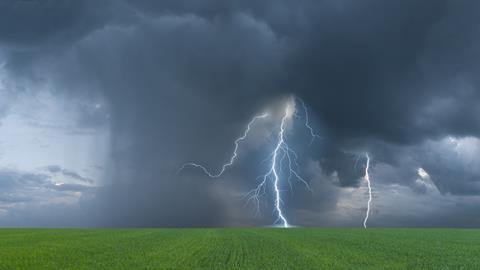Start-up business Debye is trialling space technology on lettuce crops
Technology that harnesses lightning’s nitrogen-fixing properties could revolutionise fertiliser production and supply, cut carbon emissions and support soil health, researchers claim.
The Agri-Tech Centres are working with start-up business Debye to trial its groundbreaking system, which simulates lightning’s ability to capture nitrogen in the form of nitrates when it strikes water.
Debye envisages modular and containerised systems sited on farms or hubs, giving farmers on-the-spot or local supply of nitrate-based fertiliser using only air, water and electricity.
Trials on lettuce
The 18-month feasibility R&D project is taking place on lettuce crops in Agri-Tech Centre CHAP’s vertical farming facility at Stockbridge, with fellow centre Agri-EPI providing project management and life-cycle analysis, measuring the product’s environmental and economical sustainability at each stage of its development.
The objective is to develop a one-kilowatt proof-of-concept prototype, to quantify and compare crop yields and post-harvest properties for standard nitrogen fertiliser and fertiliser produced by Debye’s machine and to determine its commercial viability.
If the trial is successful, Debye could undertake small-scale pilot projects on a farm setting within three years, subject to funding.
The project is funded by Innovate UK and the BBSRC’s ’Novel low-emission food production systems: Feasibility studies’ competition.
Space technology
Burak Karadag, who developed the technology, was originally a space engineer working on satellite propulsion, when he became interested in the properties of lightning and realised that he would like to see how he could apply space technology to grand challenges on earth.
Dr. Burak Karadag, chief technical officer, Debye Ltd said: “Fertiliser is critical to global food security, but current production methods cause environmental harm and are subject to market disruption.
“Our technology harnesses nature’s own elegant solution: lightning strikes water with such energy that it breaks apart atmospheric nitrogen molecules, creating nitrogen dioxide, which is soluble in water and readily absorbed by plants. Our technology replicates these principles using only air, water and electricity.
“Farmers rely mostly on ammonia-based fertiliser, whose economic model relies on mid- to large-scale production using natural gas and with well-documented negative effects on air, soil and water quality. Manufacturers are trying to move to green hydrogen to reduce the fertiliser’s carbon footprint, but local, renewably powered direct nitrogen capture technology could make it a near zero-emission process, locally and securely available and with far better soil health outcomes.
“Today’s synthetic fertiliser production accounts for five per cent of global greenhouse gas emissions, equivalent to half the total emissions produced by the EU27 in 2021. Just imagine if we could remove those emissions. Being a rocket scientist was undeniably exciting, but I was so motivated by the challenge of tackling climate change and enhancing food security through innovation that I was glad to make the career shift to agriculture.”




